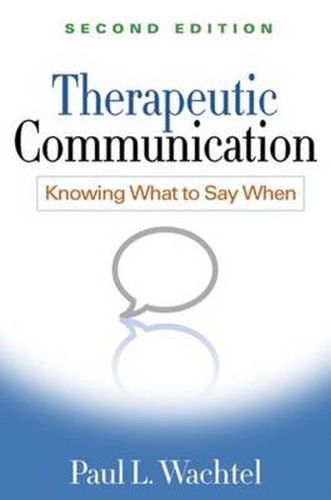Readings Newsletter
Become a Readings Member to make your shopping experience even easier.
Sign in or sign up for free!
You’re not far away from qualifying for FREE standard shipping within Australia
You’ve qualified for FREE standard shipping within Australia
The cart is loading…






A uniquely practical guide and widely adopted text, this book shows precisely what therapists can say at key moments to enhance the process of healing and change. Paul Wachtel explains why some communications in therapy are particularly effective, while others that address essentially the same content may actually be countertherapeutic. He offers clear and specific guidelines for how to ask questions and make comments in ways that facilitate collaborative exploration and promote change. Illustrated with vivid case examples, the book is grounded in an integrative theory that draws from features of psychodynamic, cognitive-behavioral, systemic, and experiential approaches. New to this edition: reflects nearly 20 years of advances in the field and refinements of the author’s approach broader audience: in addition to psychodynamic therapists, cognitive-behavioral therapists and others will find specific, user-friendly recommendations chapter on key developments and convergences across different psychotherapeutic approaches chapter on the therapeutic implications of attachment theory and research. This book will be invaluable to clinical psychologists, psychiatrists, social workers, psychiatric nurses, counselors, psychotherapy students and trainees. It will also serve as a text in graduate-level psychotherapy courses.
$9.00 standard shipping within Australia
FREE standard shipping within Australia for orders over $100.00
Express & International shipping calculated at checkout
A uniquely practical guide and widely adopted text, this book shows precisely what therapists can say at key moments to enhance the process of healing and change. Paul Wachtel explains why some communications in therapy are particularly effective, while others that address essentially the same content may actually be countertherapeutic. He offers clear and specific guidelines for how to ask questions and make comments in ways that facilitate collaborative exploration and promote change. Illustrated with vivid case examples, the book is grounded in an integrative theory that draws from features of psychodynamic, cognitive-behavioral, systemic, and experiential approaches. New to this edition: reflects nearly 20 years of advances in the field and refinements of the author’s approach broader audience: in addition to psychodynamic therapists, cognitive-behavioral therapists and others will find specific, user-friendly recommendations chapter on key developments and convergences across different psychotherapeutic approaches chapter on the therapeutic implications of attachment theory and research. This book will be invaluable to clinical psychologists, psychiatrists, social workers, psychiatric nurses, counselors, psychotherapy students and trainees. It will also serve as a text in graduate-level psychotherapy courses.